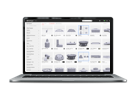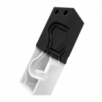Fiber reinforcement strategies
Strategies for fiber reinforcement
The key to achieving strength in 3D printing with continuous fibers is understanding where to place strands or sheets to distribute loading forces in tension or bending, as we described in 3D Printing Physics. Below, we'll outline some methods you can use to identify and place fibers in your part to increase strength where you need it.
How to think about reinforcement with continuous fibers

The design for fiber reinforcement is similar to the design for simple 3D printing, with additional consideration of strength requirements.
1. Identify the loading conditions
Take a look at your structure. Where will it be subjected to bending forces? Tensile forces? Compressive forces? If you're unsure, consider how the forces are transmitted through other parts—draw a diagram if you need to! This will help you make an informed decision about your fiber routing strategy.
2. Determine the print orientation
In which direction do the greatest forces act on your part? You should orient your part so that these forces are mostly in line with the print bed to load the fibers for bending or tensile stress. If you have many large forces spanning multiple axes, consider modifying the design or splitting it into multiple parts.
3. Determine the gain ranges
Which areas or segments need to be reinforced due to the loading conditions? Then consider what types of reinforcement you need to install in those areas.
4. Level fiberboard
If only one side of a part is reinforced, it can warp due to an uneven sandwich panel if one side is reinforced and the other isn't, or if one side has a completely different cross-section than the other. If one ply group of your part is reinforced, balance the sandwich panel by reinforcing an equivalent ply group on the farthest Z-layer with a similar cross-section.
5. Confirm the fiber installation
Does the fiber fit into the areas you need? Can you trace continuous fiber strands running along the load paths, bracing against the force? If not, you may need to adjust the fiber settings or modify features to get the fibers to run where you want them. Keep in mind that fiber groups require at least four plastic roof and floor layers to print, so any areas requiring reinforcement must start four layers away from the nearest roof or floor layer.
Basic reinforcement strategy: sheathing
Below, we'll outline a basic strategy for strengthening a printed part. This strategy will ensure your part is generally strong and resistant to bending and impact forces in every axis. As previously discussed, it's more important to reinforce the edges of your part than the core, so we'll show you how to "wrap" a part to achieve efficient strength all around.

The overwrap is a safe way to reinforce any 3D printed part with continuous fibers as it protects against most loading conditions.
1. Isotropic plates on the furthest Z-layers
To maximize flexural strength, a sandwich panel should be constructed with 2-4 layers of isotropic fibers on the top and bottom planes of the member, eliminating small surface extrusions. The fiber layers should start above the four "floor" layers or end below the four "roof" layers of a given horizontal surface.
2. Isotropic plates with major geometry changes
Add 2-4 layers of isotropic fibers below or above surfaces that cause large changes in part geometry, again considering four "roof" and "floor" layers.
3. Internal hole reinforcement for screw holes in the Z-axis
Reinforce the Z-axis bolt holes with two rings of concentric fibers. Use "inner holes only" if you don't need side load reinforcement, or use "all walls" to encompass step 4. This will distribute the compression force exerted by the bolt and create a composite "sleeve" that will resist any off-center torsional loads the bolt may experience.
4. External wall reinforcement for possible lateral loads
To maximize bending strength around the Z axis and strengthen against lateral loads, reinforce the outer walls of the part with two rings of concentric fibers. Use "Outer Shell Only" if you don't have any bolt holes in the Z axis, or use "All Walls" to include step 3. This will also reinforce any holes with axes in the XY plane.
Specialized reinforcement strategies
If you need to address more specific loading conditions, you can use different tactics to reinforce specific areas, strengthen specific part sections, or control fiber placement. Below are some unique additional strategies you can apply to your part.
Fiberboard strips

Use fiber strips for greater flexural strength. You can also stripe your parts to compensate for uneven sandwich panels.
To increase bending strength in the XY plane, you can apply "strips" of ISOTROPIC FIBER across multiple Z-layers. This is most effective for thicker parts that have a relatively uniform or symmetrical cross-section, as the fiber strips create multiple sandwich panels on top of each other, further strengthening the part during bending.
Fiber steering with ribs

When you add ribs to your 3D printed parts, the fibers are forced to follow specific stress paths.
You can route fibers in specific directions with reinforced ribs or cutouts that follow the load paths of forces acting on your part. You can force the fibers to follow these load paths by placing concentric fibers around the cutouts or walls for reinforcement.
Use of fiber angles to align fibers

Fiber angles can be used to reinforce in specific directions.
The Grain Angle tool lets you zigzag the isotropic fibers in a specific direction to better adapt to the forces acting on your part. The default setting rotates the fill pattern 45 degrees in each layer. However, you can change this by entering a specific angle or pattern of angles in the Grain Angle dialog box for any layer, any group of layers, or for the entire part.
Achieving Z-axis strength

You can work around Z-axis strength issues in 3D printing by running screws through your part.
With clever design and reinforcement strategies, you can achieve greater strength in multiple axes. Driving a screw through your part and reinforcing the compressed surfaces with isotropic fibers can strengthen the part and prevent shear or tensile forces from splitting the part at the layer lines. You can reinforce the area around the screw with concentric fibers so that these forces are distributed among the fibers in the form of bending forces.










Hinterlasse einen Kommentar